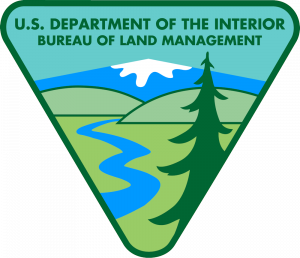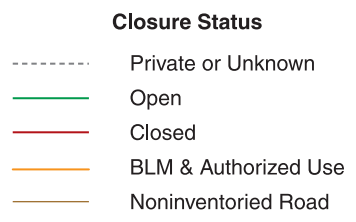Background

The Bureau of Land Management (BLM) is a United States Department of the Interior agency that administers public land in the United States. Most of this land is located in the western states and Alaska. Its mission is to sustain the health, diversity and productivity of the public lands for the use and enjoyment of present and future generations.
BLM's regulatory role in recreation use (some national monuments, camping, boating, hunting, fishing, mounting biking, driving, etc.) and commercial use (mining of minerals, coal, gas, oil, forestry, grazing, etc.) of public land means that Wazers may navigate to these locations for business and fun.
In one 2006 report (1), the BLM manages over 82,000 miles of road and more than 16,000 miles of trails. Through discussion with BLM staff, this document has not been fully adopted and there is no existing BLM-wide standard on road naming, maintenance levels, and road classification. Yet, from this document, it is clear that BLM roads and land take a different approach than other public lands such as the US Forest Service (USFS) and National Park Service (NPS).
BLM Lands seem typically less structured, supervised, and maintained than USFS and NPS and therefore are trending toward a simpler three-tier road categorization.
Waze and BLM
Creating accurate and properly represented BLM landmarks and roads:
- Benefit tourists and recreational users of NPS faculties,
- Better enables commercial use of BLM lands,
- Allows Wazers to more quickly find important landmarks, such as monuments, campgrounds, and visitor centers.
Functional Classification
BLM does not yet appear to have a consistent and approved functional classification schema; however, there is enough information to help consistency of editing. The best reference is a 2006 study and report on Roads and Trails Terminology that suggests three levels of classification for BLM roads. This should be sufficient for Waze editors to add consistency to how they represent BLM roads.

| BLM Type |
Description | Suggested Waze Road Treatment |
| Road | A linear route declared a road by the owner, managed for use by low-clearance vehicles having four or more wheels, and maintained for regular and continuous use. | Street, Primary Street |
| Primative Road |
A linear route managed for use by four-wheel drive or high-clearance vehicles. Primitive roads do not normally meet any BLM road design standards. | Off-road / Not maintained |
| Trail | A linear route managed for human-powered, stock, or off-highway vehicle forms of transportation or for historical or heritage values. Trails are not generally managed for use by four-wheel drive or high-clearance vehicles. (i.e., they are for motorcycles, ATVs, etc.) | Do Not Map |
Because BLM road maps are not all coordinated with the same functional classification, this information is not necessarily contained on BLM maps. Waze editors must use the above definitions along with personal local observation or images from the ground.

Some BLM road maps use a legend similar to that shown to the right. In this legend, roads are shown as "Open," "Closed," and "BLM Authorized Use." Waze editors should avoid mapping "closed" roads, map "open" roads, and mark "BLM Authorized Use" roads as private.
Road Naming Conventions
There is wide variability in road names for roads on BLM land. Names you might see are in general identified by a legal (numeric) description of the area based on a grid spanning the state, also known as The Public Land Survey System. BLM road numbers are determined by township, range and section numbers where the road originates. The following convention is suggested for naming roads on BLM land in Waze:
- Public highways and county roads should be named under conventions for the state or region. Do not use a BLM road number/name for these roads.
- BLM roads with popular names as shown on posted road signs should be named per the road signage. BLM maps do not usually show these popular names. Verify with street-view or local knowledge to verify before changing names from a popular name to a BLM road number.
- If an area's BLM routes have a preceding letter in front of the route number, use that letter and number.
- BLM roads that are not named with an alternative naming convention should be named "BLM-XXXX" where XXXX is the BLM route number.
Editing Resources
The BLM publishes a number of georeferenced PDF maps.
State-specific Pages
State-specific editing resources including PDF maps and GIS data can be found at the following BLM web pages:
Alaska Frequently Requested Maps
Arizona Frequently Requested Maps
Colorado BLM Interactive Map GIS
California BLM Interactive Map GIS
New Mexico BLM Interactive Map GIS
Oregon and Washington BLM Transportation Maps
Wyoming BLM Frequently Requested Maps
National Monuments
BLM's National Conservation Lands include 19 national monuments in western states of Arizona, California, Colorado, Idaho, Montana, New Mexico, Oregon, Utah, and Washington. See their National Monuments for details. These will be likely destinations for Wazers.
Similar Road Systems
References
(1) Roads and Trails Terminology Report, 2006
(2) Discussions with BLM GIS staff.